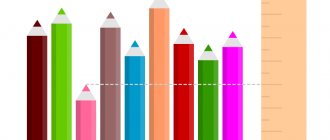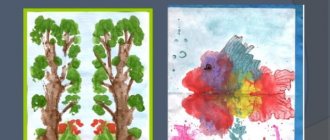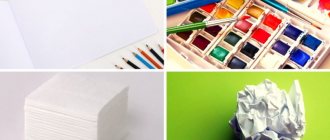Excerpt from the text
The relevance of research.
It can be said without exaggeration that for the modern educational system the problem of mental education is extremely important. In the works of domestic and foreign scientists, preschool age is defined as the optimal period for mental development and education.
Mental education is carried out as a process of assimilation by the younger generation of the experience of humanity, imprinted in material culture, spiritual values, presented in knowledge, abilities, skills, ways of knowing, etc. In the process of cognition, representation is a transitional stage from sensation and perception to thinking.
One of the important tasks of mental education is the formation of ideas about objects and phenomena of the surrounding reality.
The main function of mental education is the formation of cognitive activity, i.e. such activities during which the child learns about the world around him.
The process of sensory cognition in younger preschoolers is carried out in various types of activities: play, work, walks, classes, and communication with adults and peers.
In the course of analyzing the results of research by Z.A. Bogateeva, L.V. Kutsakova, L.A. Paramonova and others, it was proven that one of the means of forming ideas is children's design using different materials. It is of great importance for the development of a child’s personality. In its vein, conditions are created for the development of imagination (L.S. Vygotsky, V.V. Davydov, O.M. Dyachenko, etc.), intellectual activity (D.B. Bogoyavlenskaya), experimentation with material (E.A. Flerina , N.N. Poddyakov), the emergence of bright and “smart” emotions (A.V. Zaporozhets).
This allows us to consider children's construction a powerful means of developing creativity in preschoolers.
However, great opportunities lie in teaching papermaking. In the process of learning this type of activity, sensations and perceptions most actively develop. With the help of sensory perception, the child learns individual signs and properties of the paper with which he directly comes into contact and acts. Classes in the paper-plastic technique contribute to the development of the muscles of the hands, improve the eye, dexterity, develop strong-willed qualities, hard work, the ability to analyze, and think independently. Such classes serve as good preparation for mastering the skill of writing in the future. Therefore, they need to be included in the educational process of preschool institutions.
Having analyzed a number of programs for the upbringing and training of preschool children, it was revealed that learning objectives for the formation of ideas about the properties of paper are set starting from the middle group.
However, research by L.A. Paramonova show that children can become acquainted with the properties and qualities of paper not only in classes on familiarizing themselves with the world around them, but also in classes on paper construction. First of all, you need to introduce children to the different properties of paper (it can be soft and hard, of varying thickness and strength, matte, shiny, smooth, rough and all kinds of colors).
Explain how you can work with it in different ways (crumpling, tearing, twisting, gluing, creating different shapes).
In this regard, the problem of the study is that, on the one hand, scientists have proven the need for the formation of ideas. However, the theory does not provide a justification for the possibility of forming ideas about the properties of paper in the process of teaching papermaking. On the other hand, in the practice of preschool education, teaching paper plastic in order to form ideas about the properties of paper is not always used or not fully used.
In this regard, the object of the study is the process of forming ideas about the properties of paper in children of primary preschool age.
The subject of the study is the influence of the process of teaching papermaking on the formation of ideas about the properties of paper in children of primary preschool age.
The purpose of the study is to determine the pedagogical conditions for the formation of ideas about the properties of paper in children of primary preschool age in the process of learning papermaking.
The hypothesis of our research is the following assumption: the formation of ideas about the properties of paper in children of primary preschool age in the process of learning papermaking will be successful if:
• the teacher will master the methodology of forming ideas about the properties of paper and the technology of teaching papermaking;
• along with training in papermaking, targeted formation of ideas about the properties of paper will be carried out;
• selection of the content of the topics for teaching papermaking will take into account the age characteristics of younger preschoolers.
The objectives of the study are formulated in accordance with its purpose and are aimed at ensuring that the research hypothesis is confirmed:
1) analyze the state of the problem of forming ideas about the properties of paper in children of primary preschool age in the process of teaching paper plastics in the theory and practice of preschool education;
2) to identify the level of ideas of 4-5 year old children about paper and its properties;
3) develop and test a series of classes on developing ideas about the properties of paper in the process of teaching papermaking;
4) develop methodological recommendations for preschool teachers, with the possibility of using the developed cycle of classes in the practice of other preschool educational institutions.
To solve the problems set in the study, the following methods were used:
• theoretical methods (theoretical analysis of psychological and pedagogical literature);
• empirical methods (observing children, talking with teachers, studying the products of children's activities, diagnosing children);
• quantitative and qualitative analysis of research results.
The theoretical significance of the study is as follows: the meaning and means of forming ideas about the objective world in children of primary preschool age are theoretically substantiated; the essence of the concept of “paper plastic” is revealed, its specificity and capabilities are shown in the formation of ideas about the properties of paper in the theory and practice of preschool education; the criteria and levels of formation of ideas about the properties of paper are determined.
The practical significance of the study lies in the possibility of using the proposed methods for diagnosing the formation of ideas about the properties of paper; use of the developed cycle of classes in the practice of other preschool educational institutions.
Research base.
Experimental work was carried out on the basis of the State Educational Institution kindergarten No. 1427 in Moscow using the method of pedagogical experiment in the period from September to December 2007. The study involved children from two middle groups of 15 people each, which received the status of experimental and control.
Main stages of the study:
Stage 1: theoretical analysis and generalization of psychological and pedagogical literature on the research problem, design of the first chapter of the study of the existing practice of forming ideas about the properties of paper in children of primary preschool age when teaching papermaking, formation of a research hypothesis, clarification of its topic;
Stage 2: preparation and conduct of experimental work, summing up, preparation of the second chapter of the study. Development of a set of classes, quantitative and qualitative analysis of the experiment results, formulation of conclusions and methodological recommendations for practitioners.
Stage 3: designing the work, writing an introduction and conclusion.
Structure of the thesis.
The thesis consists of an introduction, two chapters, a conclusion, a list of references and an appendix.





